Alliums are known for their striking, globe-shaped flower heads and tall, sturdy stems, making them a popular choice among gardeners. Their unique architectural beauty adds visual interest to borders, containers, and landscapes. In this guide, we will cover everything you need to know about planting, growing, and maintaining alliums, as well as the benefits of both ornamental and edible varieties. Our gardening blog is a perfect place to find all the information you need!
Understanding Alliums
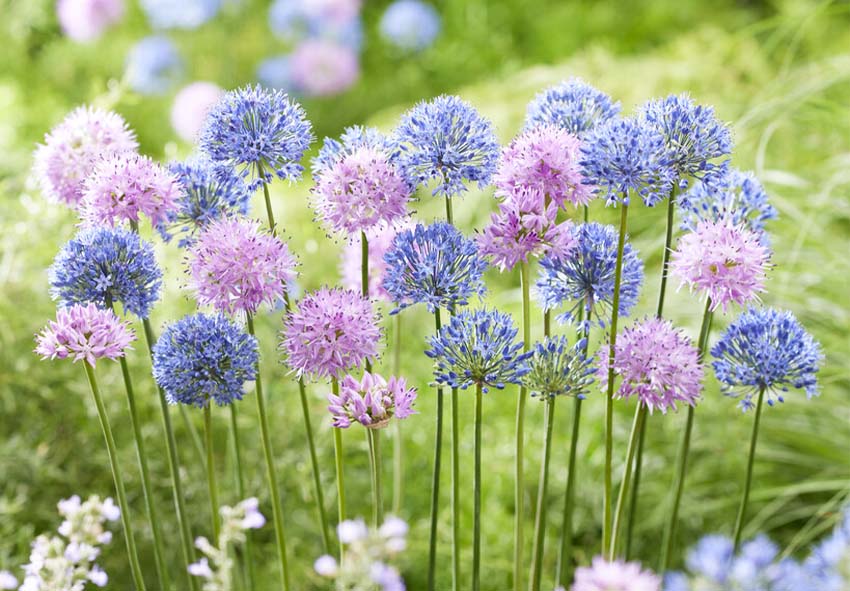
Alliums are a diverse group of plants that include both ornamental species and common kitchen staples like garlic and onions. They are valued for their showy flowers, which bloom in vibrant purples, whites, and pinks, and their ability to thrive in various garden environments. Understanding the different types of alliums and how to care for them is essential for any gardener looking to enhance their space with these stunning plants.
What Are Alliums?
Alliums belong to the Allium genus, which is part of the Amaryllidaceae family and includes over 700 species. These plants are characterized by their round flower heads, which are clusters of tiny star-shaped blossoms. Both ornamental and edible alliums share the same basic characteristics: tall, hollow stems and strap-like leaves that die back before the flowers bloom. From giant alliums used for dramatic garden displays to smaller varieties used in culinary applications, alliums are versatile plants with many uses.
Popular Allium Varieties
Some of the most popular ornamental alliums, known for its large, striking flower heads, include:
| Botanical Name | Colour | Flowering Period | Preferred Climate | Soil Conditions |
| Allium giganteum | Purple | Late Spring to Early Summer | Warm, temperate climates | Well-drained, loamy soil |
| Allium ‘Purple Sensation’ | Purple | Late Spring to Early Summer | Temperate, mild climates | Moist, well-drained soil |
| Allium schoenoprasum | Light Purple (Chives) | Late Spring | Cool to temperate climates | Fertile, well-drained soil |
| Allium sativum | White (Garlic) | Summer | Warm, temperate climates | Loamy, well-drained soil |
| Allium moly | Yellow | Late Spring to Early Summer | Temperate to warm climates | Well-drained, sandy or loamy soil |
How to Grow Alliums
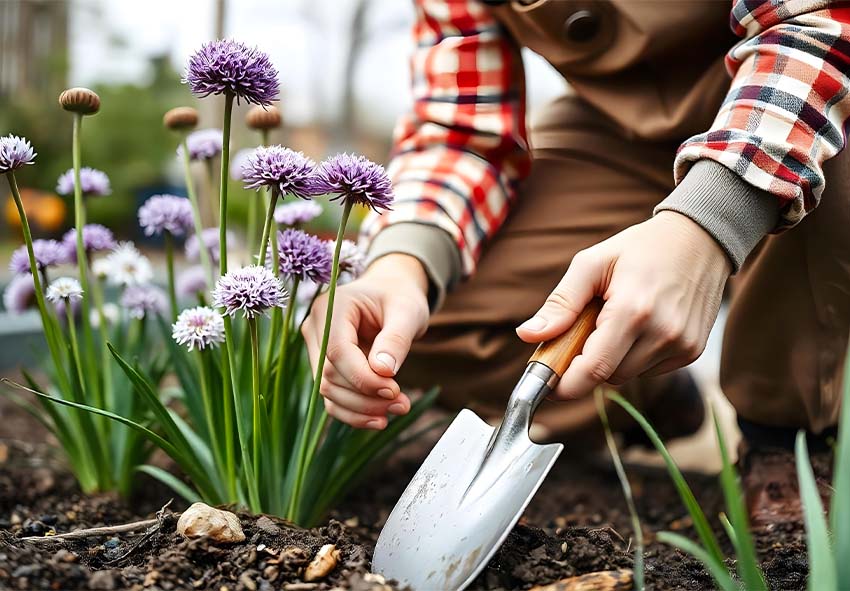
Growing alliums is relatively easy, as long as you provide the right conditions. They prefer sunny spots and well-drained soil to prevent bulb rot. Planting at the right time and following proper care routines ensures a lush display of blooms year after year.
Choosing the Right Location
Alliums thrive in full sun, meaning they need at least 6 hours of sunlight each day. This light exposure promotes healthy growth and vibrant blooms. In addition, alliums prefer well-drained soil to avoid sitting in water, which can lead to bulb rot. When choosing a planting location, make sure it offers both adequate sunlight and good soil drainage to maximize your allium’s potential.
Preparing the Soil
Alliums grow best in slightly acidic to neutral soil with a pH level between 6.0 and 7.0. It’s important to ensure that the soil is loose and well-drained. If your garden has heavy clay or compacted soil, consider amending it with organic matter such as compost or sand to improve aeration and drainage. A healthy, nutrient-rich soil foundation helps ensure strong root development and robust blooms.
When to Plant Allium Bulbs
The best time to plant allium bulbs is in the fall, typically between September and October, depending on your local climate. This allows the bulbs to establish roots before the winter frost sets in. Alliums are hardy and can survive cold winters, but planting at the right time ensures they bloom beautifully in late spring or early summer. Planting too late may lead to weak plants or delayed blooms.
Planting Allium Bulbs
When planting allium bulbs, it’s essential to follow some main tips:
- Dig Planting Holes: Create holes that are two to three times the height of the bulb (around 4-6 inches deep). Space each hole about 4-6 inches apart.
- Place Bulbs in Holes: Position the bulbs with the pointed end facing up and the flat end down. Ensure the bulbs are planted at the correct depth to encourage healthy growth.
- Cover with Soil: Gently fill the holes with soil, making sure the bulbs are fully covered.
- Water the Area: Water the bulbs lightly after planting to help them settle into the soil, but avoid waterlogging.
- Apply Mulch: Add a layer of mulch (such as straw or bark chips) around the planting area to retain moisture and protect the bulbs during winter.
- Monitor Growth: Keep an eye on the planted area for signs of sprouting in the spring and provide additional care as needed.
Allium Care and Maintenance
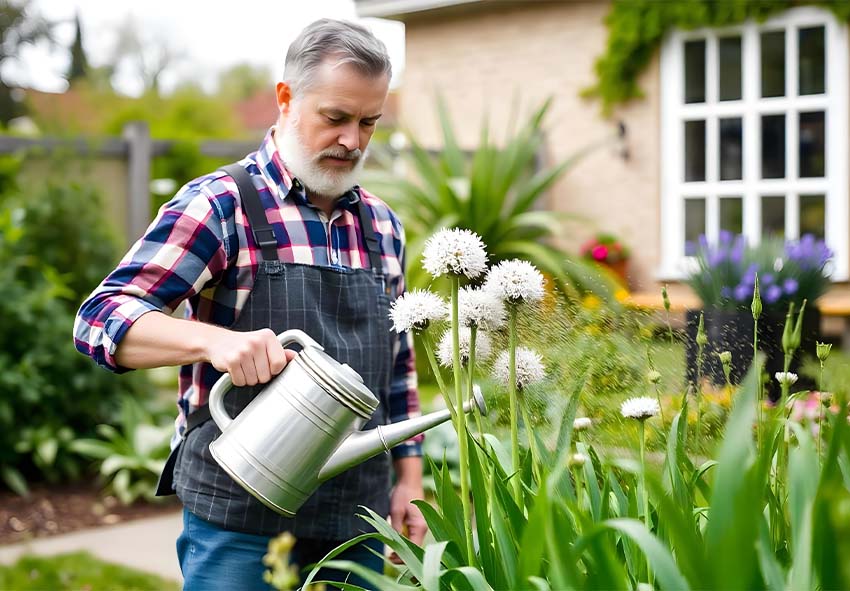
While alliums are low-maintenance plants, providing them with proper care can result in healthier, more vibrant blooms. Regular watering, fertilization, and pruning are all part of keeping your alliums looking their best. Following these simple care steps will ensure that your alliums continue to thrive and produce beautiful flowers year after year.
Watering Needs
Alliums require consistent watering during their initial growing phase, especially when first planted. Water them deeply to encourage root development but allow the soil to dry out between watering sessions to avoid overwatering. Once established, alliums are relatively drought-tolerant and only need watering during prolonged dry periods. Be careful not to overwater, as too much moisture can lead to bulb rot.
Fertilizing Alliums
Fertilizing alliums can help promote vigorous growth and larger blooms. It’s best to apply a balanced, slow-release fertilizer in early spring when the shoots first emerge. Avoid high-nitrogen fertilizers, which can lead to excessive foliage growth at the expense of flowers. A single application in the spring is usually sufficient, but for poor soils, you can add an additional dose of fertilizer after blooming to help the bulbs store nutrients for the next season.
Mulching for Alliums
Applying a layer of mulch around your alliums helps retain moisture, suppress weeds, and protect the bulbs during winter. Organic mulches such as bark chips, straw, or compost work well and break down over time, adding nutrients to the soil. Mulch also helps regulate soil temperature, which is especially important during the hot summer months and cold winters.
Pruning and Deadheading
Pruning and deadheading are important tasks for maintaining alliums. After the alliums have finished blooming, it’s a good idea to deadhead the spent flower heads to prevent them from self-seeding, which can deplete the plant’s energy. However, leaving the seed heads intact can provide architectural interest in the garden through winter. Pruning back yellowing foliage in late summer allows the plant to focus its energy on bulb development for the next growing season.
Propagation
Alliums can be propagated through division or seeds. To propagate by division, dig up the bulbs in the fall and separate the offsets from the main bulb. Replant them immediately in a prepared bed for next year’s growth. Growing alliums from seed is a slower process, but it allows you to grow more plants from a single bulb. Seed-grown alliums may take several years to reach maturity.
Managing Pests and Diseases
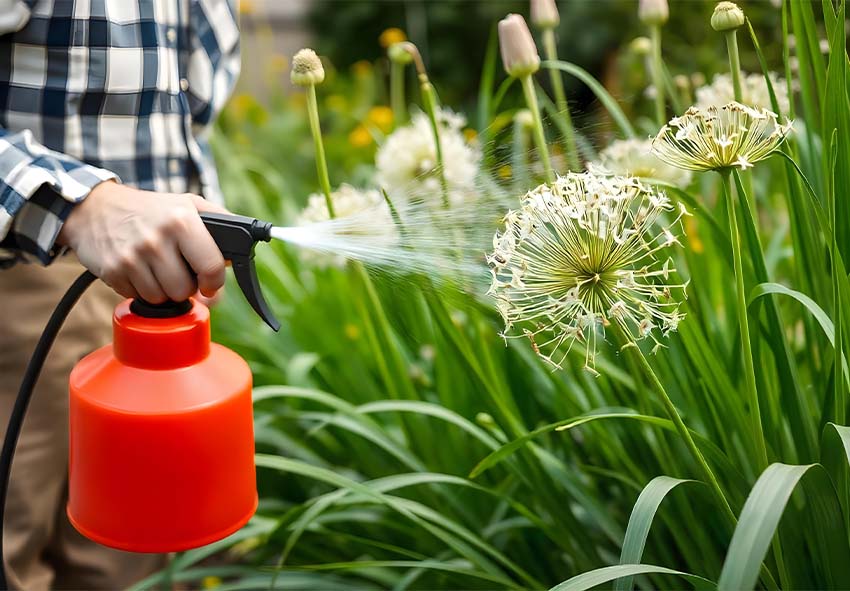
Alliums are generally resistant to most pests and diseases, but they are not entirely immune. Paying attention to early signs of infestations or infections will help you prevent major damage. Regularly inspecting your alliums and taking swift action when needed ensures healthy plants and abundant blooms.
Common Allium Pests
While alliums are known for their pest-repelling qualities, they can still attract pests such:
- Onion Flies: Onion flies lay eggs at the base of allium plants, and their larvae feed on the roots, causing wilting and yellowing.
- Aphids: Aphids suck sap from allium leaves, leading to distorted growth and the spread of plant viruses.
- Nematodes: These microscopic worms invade the roots and bulbs, stunting plant growth and causing deformities.
- Thrips: Thrips damage allium leaves by sucking plant juices, leaving silvery streaks and discoloration on the foliage.
- Leaf Miners: Leaf miners burrow into the leaves, creating tunnels that reduce the plant’s ability to photosynthesize efficiently.
Preventing Allium Diseases
Common diseases affecting alliums include downy mildew, rust, and white rot. These fungal diseases can cause discoloration, stunted growth, and bulb rot if left untreated. To prevent these issues, plant alliums in well-drained soil and avoid overhead watering. Good air circulation around the plants also helps reduce the risk of fungal infections. Rotate your allium crops annually, especially for edible varieties, to minimize the spread of soil-borne diseases.
Designing with Alliums in Your Garden

Alliums are a versatile plant that can be used to add visual interest and structural elegance to any garden. Whether used in borders, containers, or combined with other plants, alliums are a perfect addition to any garden design. Their tall, striking stems and long-lasting blooms make them an ideal focal point or companion plant.
Companion Planting for Alliums
Companion planting is an effective way to maximize the benefits of growing alliums in your garden. By strategically pairing alliums with other plants, you can improve soil health, deter pests, and enhance the visual appeal of your garden beds. Alliums are particularly effective at repelling insects, making them ideal companions for a variety of crops and flowers:
- Carrots: Alliums repel carrot flies, while carrots benefit from the alliums’ pest-deterrent properties.
- Tomatoes: Planting alliums near tomatoes helps deter pests like aphids and spider mites, improving tomato health.
- Roses: Alliums planted around roses help repel aphids and enhance the growth and bloom quality of rose bushes.
- Strawberries: Alliums deter slugs and pests that commonly affect strawberries, helping to protect the fruit.
- Beets: Both plants grow well together, with alliums providing natural pest resistance to protect the beets from insects.
Using Alliums in Borders and Containers
Alliums add vertical height and drama to garden borders, making them ideal for layering with shorter plants. Place them in the middle or back of flower beds for a bold impact. They also thrive in containers, providing a burst of color and structure on patios or balconies. When planting in containers, ensure proper drainage and use a well-draining soil mix to prevent waterlogged roots.
Harvesting and Usage of Edible Alliums
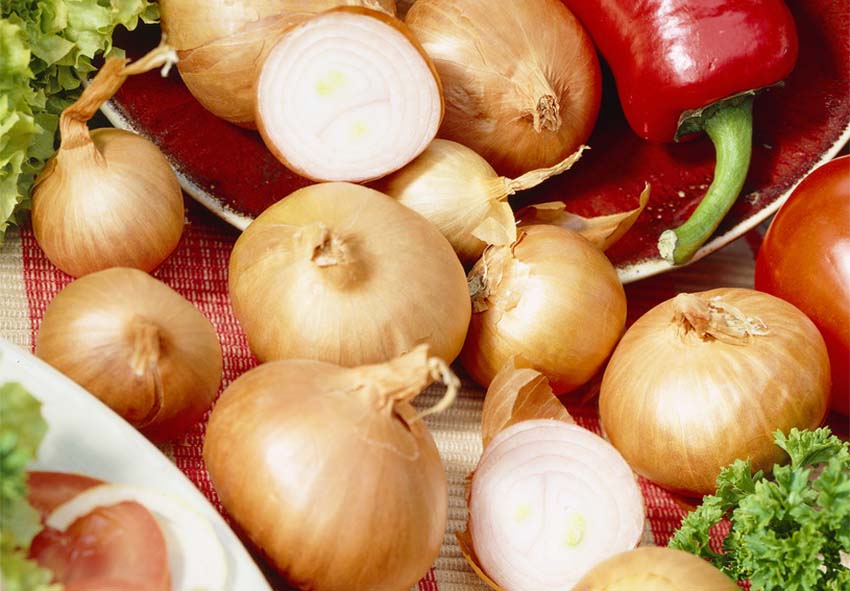
Many allium varieties, such as garlic, onions, and leeks, are not only beautiful but also highly practical for kitchen use. Harvesting and using edible alliums adds flavor and nutrition to your meals while enhancing your garden’s overall productivity. Learning when and how to harvest these crops will ensure you get the most out of your edible alliums.
Harvesting Garlic, Onions, and Leeks
Harvesting alliums like garlic, onions, and leeks at the right time is crucial to ensure the best flavor and storage quality. Knowing when and how to harvest these plants can lead to a successful and bountiful crop that lasts well into the off-season. Each type of allium has specific signs that indicate it’s ready to be harvested, which ensures maximum flavor and longevity:
- Garlic
Harvest garlic when the lower leaves turn brown but the upper leaves are still green. Gently loosen the soil and pull up the bulbs.
- Onions
Onions are ready to harvest when their tops fall over and begin to dry. Lift the bulbs and let them cure in a warm, dry area for a few weeks.
- Leeks
Leeks can be harvested when they reach the desired size. Simply pull them from the ground or dig around them if the soil is compact. They can be harvested over a long period during their growing season.
Usage of Edible Alliums
Edible alliums like garlic and onions are indispensable in the kitchen for adding depth and flavor to a wide variety of dishes. They can be used fresh, cooked, or even preserved for later use. Garlic and onions can be roasted, sautéed, or pickled, while leeks are delicious in soups, stews, and casseroles. Additionally, these alliums have medicinal properties, known for their immune-boosting and anti-inflammatory effects.
Conclusion
Alliums are an excellent choice for gardeners looking for beauty, versatility, and low maintenance. Whether you’re growing ornamental varieties for their striking blooms or edible types for your kitchen, alliums are easy to care for and rewarding to grow. Explore the various allium species to enhance your garden’s visual appeal and enjoy the culinary benefits they bring.
Frequently Asked Questions (FAQs) about Alliums
1. When is the best time to plant allium bulbs?
The ideal time to plant allium bulbs is in the fall, typically between September and November, before the ground freezes. This allows the bulbs to establish roots during the winter and bloom in late spring or early summer. Alliums require cold weather to trigger their growth cycle.
2. Can I order Allium bulbs from your online store?
Yes, you can! Our online store Dutch-bulbs.com offers a wide selection of Allium plants, including different varieties and colors. We take pride in providing top-quality plants that are carefully cultivated and shipped with care to ensure they reach you in perfect condition. Visit our online store to explore our collection and place your order for a delightful addition to your home or garden.
3. How much sunlight do alliums need?
Alliums thrive in full sunlight, requiring at least 6 hours of direct sunlight per day. While they can tolerate partial shade, more sunlight promotes stronger stems and better flowering. Plant them in a bright, open location to ensure healthy blooms and to prevent them from becoming leggy.
4. How do I care for alliums after they bloom?
After blooming, allow the foliage to die back naturally. This helps the bulb store energy for the next season. You can deadhead spent flowers to prevent self-seeding. Water sparingly, especially if the weather is dry, and avoid fertilizing once the flowers have faded.
5. Are alliums resistant to pests and diseases?
Alliums are generally pest-resistant due to their strong scent, which deters many insects. However, they can occasionally suffer from pests like onion flies, thrips, and nematodes. Proper spacing, good air circulation, and avoiding overwatering help prevent diseases like downy mildew and rust.
Published: 20.09.2024
